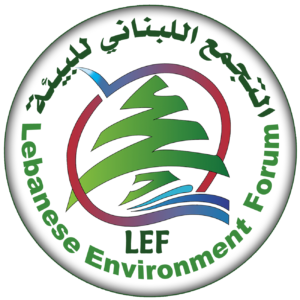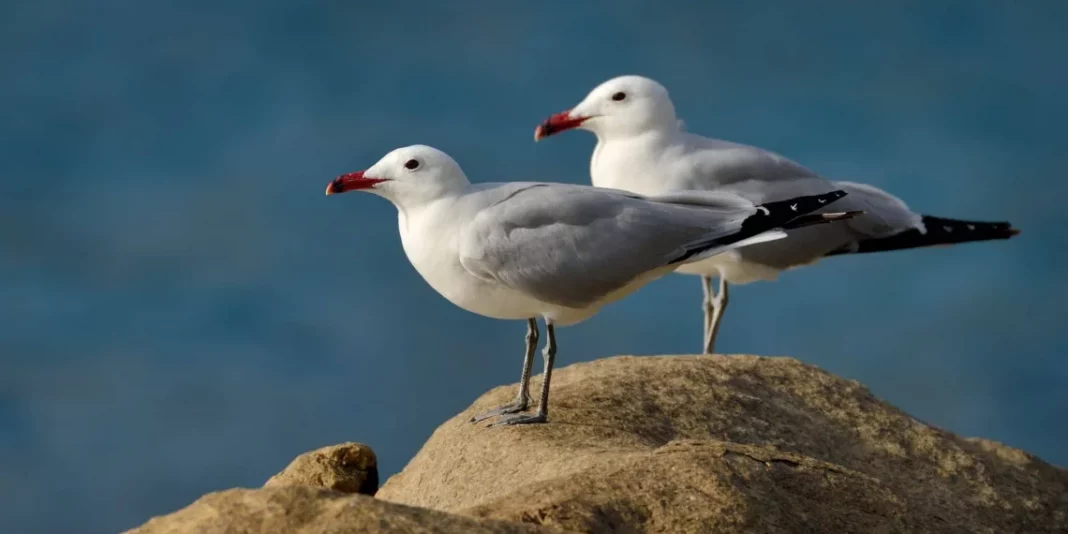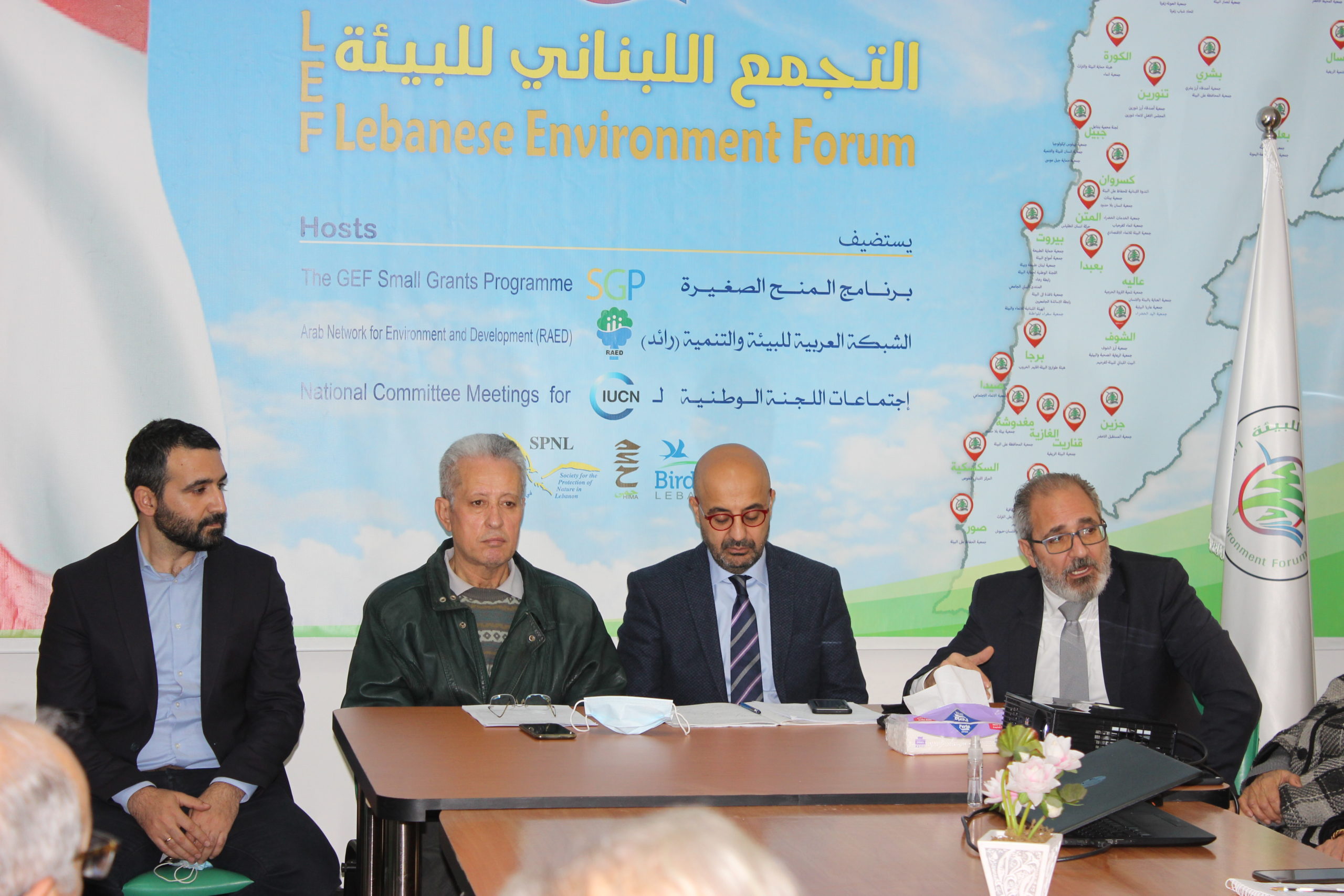Ghassan Ramadan-Jaradi
National Council for Scientific Research, P.O.Box 118281, Beirut, Lebanon Faculty of Science, Lebanese University, Hadath, Lebanon grjaradi@cnrs.edu.lb. (Received January 2019 – Accepted January 2020)
Lebanese Science Journal, Vol. 21, No. 1, 2020 37
ABSTRACT
Ramadan-Jaradi, G. (2020). Annotated Checklist of the Marine and Coastal Birds of Lebanon. Lebanese Science Journal, 21(1), 37-53.
The study of marine and coastal birds in the Lebanon recorded 75 species along the shore line of Lebanon and for a distance of 7 kms offshore. Of those species, 35 are seabird species, 38 marine or seawater/freshwater coastal birds, and 2 waterbird species wintering on the archipelagoes of Mina/Tripoli in North Lebanon (Grey Heron and Little Egret) with apparently much affinity to seawater in the winter season. This study highlighted 3 globally threatened species (Leach’s Storm Petrel Hydrobates leucorhoa [Vulnerable], Mediterranean Yelkouan Shearwater Puffinus yelkouan [Vulnerable], and Dalmatian Pelican Pelecanus crispus [Vulnerable]), underlined 7 globally Near Threatened avian species, pointed out to 3 species that may be submitted for reconsideration by the “Lebanon Bird Record Committee” (LBRC) at LCNRS; and updated the data of 9 species of high significance from the past studies, of which, 2 species are upgraded from vagrants to winter visitors/passage migrants, one to passage migrant and one to winter visitor.. Regarding the final phenological statuses of species, one is resident breeding, one is summer breeding, 3 are formerly bred, one extirpated (extinct) from Lebanon 31 are passage migrant/winter visitors, 25 passage migrants only, 2 winter visitors and 14 vagrant species.
Keywords: seabirds, coastal birds, migrating, wintering, breeding, status, phenology, threat, distribution.
INTRODUCTION
Unlike the terrestrial bird species, the seabirds and coastal birds have not received much attention from the bird surveyors in Lebanon. Out of the 54 bird observers that published scientific ornithological papers on Lebanon, only 10 have mentioned seabirds and coastal birds in their publications with most of published papers are for the author of this manuscript. They are: Stenhouse (1904), Cawkell (1944), Hollom (1959), Kumerloeve (1962), Tohmé & Neuschwander (1974), Macfarlane (1978), Evans (1994), Ramadan-Jaradi and Ramadan-Jaradi (1997), Bara (1998), Busuttil & Flumm (1998), Ramadan-Jaradi and Ramadan-Jaradi (1999, 2001, 2002), Ramadan-Jaradi et al. (2004), Ramadan-Jaradi et al. (2005), Ramadan-Jaradi (2006), Ramadan-Jaradi et al. (2008), Ramadan-Jaradi (2010, 2017a, 2017b, 2017c), and Ramadan-Jaradi & Itani (2018).
However, since the previous checklist of the birds of Lebanon (Ramadan-Jaradi et al., 2008), many significant changes in the status and distribution of sea and coastal birds have been recorded. Checklists are never permanent, but the one presented here now relates more closely to a more standardized taxonomic approach being adopted for the OSME (Ornithological Society of the Middle East) Region, through the developing OSME Regional List (ORL) of bird taxa. (OSME) Region List is available on www.osme.org/ORL. It is worth noting that the ORL follows the International Community of Ornithologists (IOC) World Bird List (hereinafter IOC, downloadable at http://www.worldbirdnames.org/) taxonomy and nomenclature in principle, but where some divergence better highlights a tax on, exceptions are made and rationale are given.
Our present checklist follows this ORL List but it will be limited to Marine and Coastal Birds only. It will be a subject for the Lebanon Birds Rarities Committee (LBRC) to discuss and debate, which is why we present a number of taxa as hypothetical at present, because acceptance standards have rightly become more stringent as the subtle ties of bird identification have become better understood and more widely disseminated. Of the 407 recorded taxa in Lebanon (Ramadan-Jaradi et al., in preparation), 8.6% are seabirds, 9.83% are coastal birds (waders) including 2 waterbird species (Little Egret and Grey Heron) for being frequently seen on the coast and the islets during their passage in spring and autumn and during the wintering season too. Consequently, this checklist deals with 18.43% of the country’s avifauna. In addition, the present checklist will most probably serve as a baseline study that may assist identifying future impact on birds of offshore windfarms or future sea-based offshore platforms and drilling rigs for oil.
What are seabirds and coastal birds?
Seabirds spend most of their lives at sea. For this reason, they have developed a
range of characteristics adapted to the marine environment (BirdLife International, 2018).
There exists no single definition of which groups, families and species are seabirds, and most definitions are in some way arbitrary. In the words of several seabird scientists, “The one common characteristic that all seabirds share is that they feed in saltwater; but, as seems to be true with any statement in biology, some do not. However, by convention all of the Sphenisciformes and Procellariiformes, all of the Pelecaniformes and Suliformes except the darters, and some of the Charadriiformes (the skuas, gulls, terns, auks and skimmers) are classified as seabirds (Tully et al., 2009). The phalaropes are usually included as well, since although they are waders, two of the three species are oceanic for nine months of the year, crossing the equator to feed pelagically (Steele, 2008).
Loons and grebes, which nest on lakes but winter at sea, are usually categorized as waterbirds, not seabirds (Steele, loc. Cit.). Although there are a number of sea ducks in the family Anatidae that are truly marine in the winter, by convention they are usually excluded from the seabird grouping. Many waders and shorebirds are also highly marine, living on the sea’s edge (coast), but are also not treated as seabirds, even though, they are incorporated as coastal or shore birds in the present study. Accordingly, there are 35 seabird species in Lebanon, comprising, gulls, terns, shearwaters, petrels and skuas, and 40 coastal or shore birds comprising, some herons, stints, turnstones, sandpiper, godwits, pratincoles, etc.
Background
The marine and coastal avifauna of Lebanon are severely degraded predominantly due to a lack of knowledge about their species diversity and subsequently lack of coordination and management amongst the various sectors responsible for the marine and coastal zone, combined with a lack of consolidated data and information on the marine and coastal avifauna and limited awareness of the value and need for appropriate management amongst stakeholders. As such the present checklist has been proposed to address all the marine and coastal bird species in Lebanon as a prior step towards highlighting elsewhere the so-called priority species within datasheets, especially when it is time to protect them from potential collision with future sea windfarms.
The Lebanese coastline extends 220 km from the border in the North to Naqoura in the South along the eastern Mediterranean. It is mainly a rocky shoreline with stretches of sand (20%) and pebbles inhabited by a variety of common and endangered marine and coastal bird species (MoE, IUCN, UN Environment and GEF, 2018). The degradation of the coastline and the sea quality under the impact of chaotic urbanization increased the number of threatened bird species at the national level (Ramadan-Jaradi, pers. obs.). The degradation of the coastline is not the only reason behind the decline of marine and coastal birds as unfortunately, the dynamiting and the poisoning of fish with fish-poisoning products have an impact on human health and also repercussions threatening the life of sea birds that may feed on these poisoned fish (in July 2018, over 40 Yellow-legged Gulls were found dead or morbid on the beaches of Palm Islands Nature Reserve (Ramadan- Jaradi, pers. obs.). Post-mortem proved that they were poisoned by fish poisoning products ingested by fish that are eaten on their turn by sea birds. On beaches, gull’s eggs are stolen by fishermen to use them as aphrodisiac food. Gulls, waders and marine birds are killed by trash accidentally ingested; and in the sea the diving cormorants are caught by fishing nets. These destructive activities are predominantly due to the lack of law enforcement capacity and the current overlap and conflict among existing legislation and institutional mandates (Palm Islands Nature Reserve [PINR], 2018).
In view of the current situation of the Lebanese coastline and associated marine and coastal ecosystems and biodiversity, there is an intention to mainstream marine and coastal avifauna into national plans and coastal zone management plans, with particular focus on the impact of climate change on avian marine species. The present study provides an opportunity for the protection of key marine and coastal avian biodiversity to be included in coastal zone management plans as they are essential to the proper management of the marine ecosystem in Lebanon.
METHODOLOGY
The methodology used depends on the objectives of the present study that are to determine the seabird species, their phenological and conservation statuses, their frequency/abundance as well as their national distribution. Accordingly, we surveyed the study area, along the shore line and up to 7 km offshore, between early December 2016 and early December 2018 with the point counts method during the breeding season (March-May) and linear transects during the remaining months of the year, often between 08:30 and 16:00 hr. The point counts method used was that described by Blondel et al. (1981) and successfully used by the author of this paper in his doctoral thesis in the desert of UAE (1984). The points are randomly selected within a stratified sampling process to provide representative samples of the study area (for more details on this methodology see Ramadan-Jaradi, 2017d).
It is worth to note that for each species of low occurrence, we added the old records from the past whether they are from the coastal area or from the inland wetlands. This was necessary to put the uncommon and rare species in a wider context.
How to use the checklist
Taxa are sequenced according to IOC order. For each taxon, its Common Name, Arabic Name, and Scientific Name are given. Global IUCN Threat Status (TS) is provided. This is an annotated checklist that provides a description of the distribution of each taxon.
Threat Status (TS) index
CR = Critically Endangered EN = Endangered
VU = Vulnerable
NT = Near Threatened
LC = Least Concern:
LC = Grey boxes and italicized Threat Status categories indicate OSME estimated status
Phenological Status
The Phenological Status is also given with the following abbreviations:
A question mark indicates uncertain status.
Lower case abbreviations (eg r, sb, s, wv and pm) indicate that the species is uncommon or rare at the relevant season.
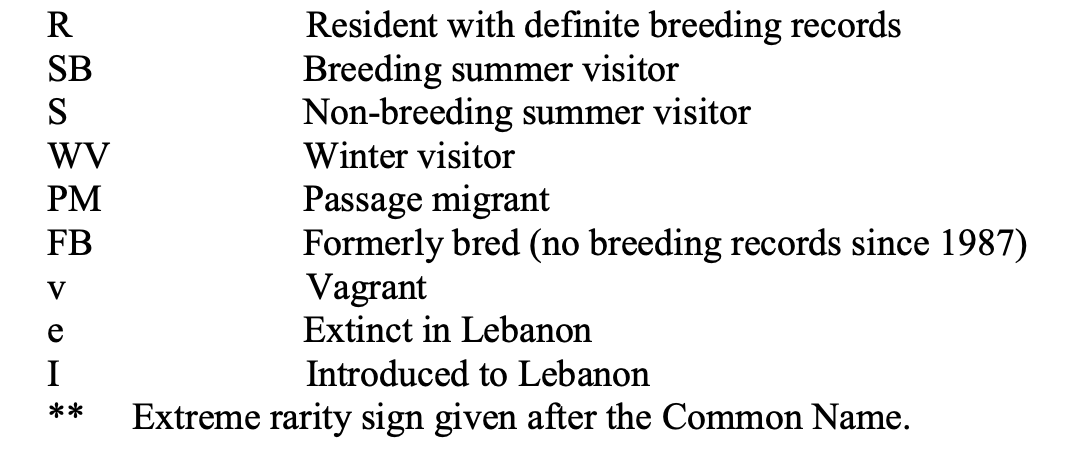
Hereinafter, we divide the annotated list into 2 categories, one for the marine and pelagic (seabirds) species and one for the shore or coastal bird species that may have marine/freshwater life.
Marine Avian Species (Table 1)
Table 1. Annotated checklist of the marine bird species.
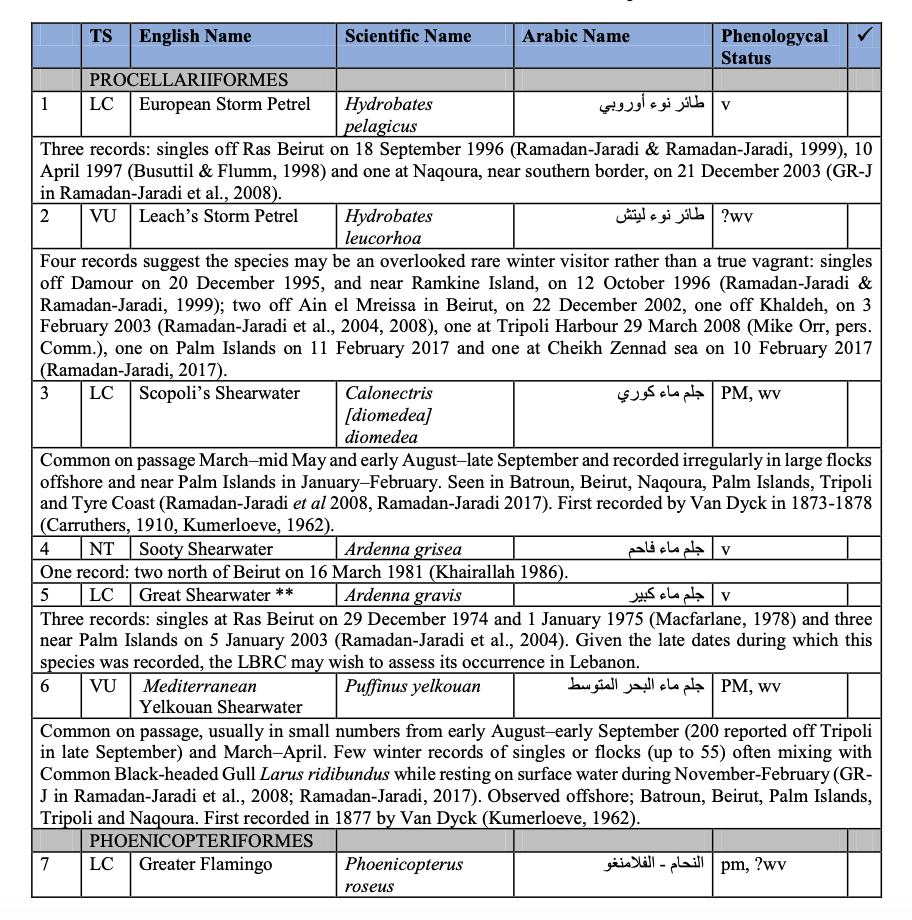
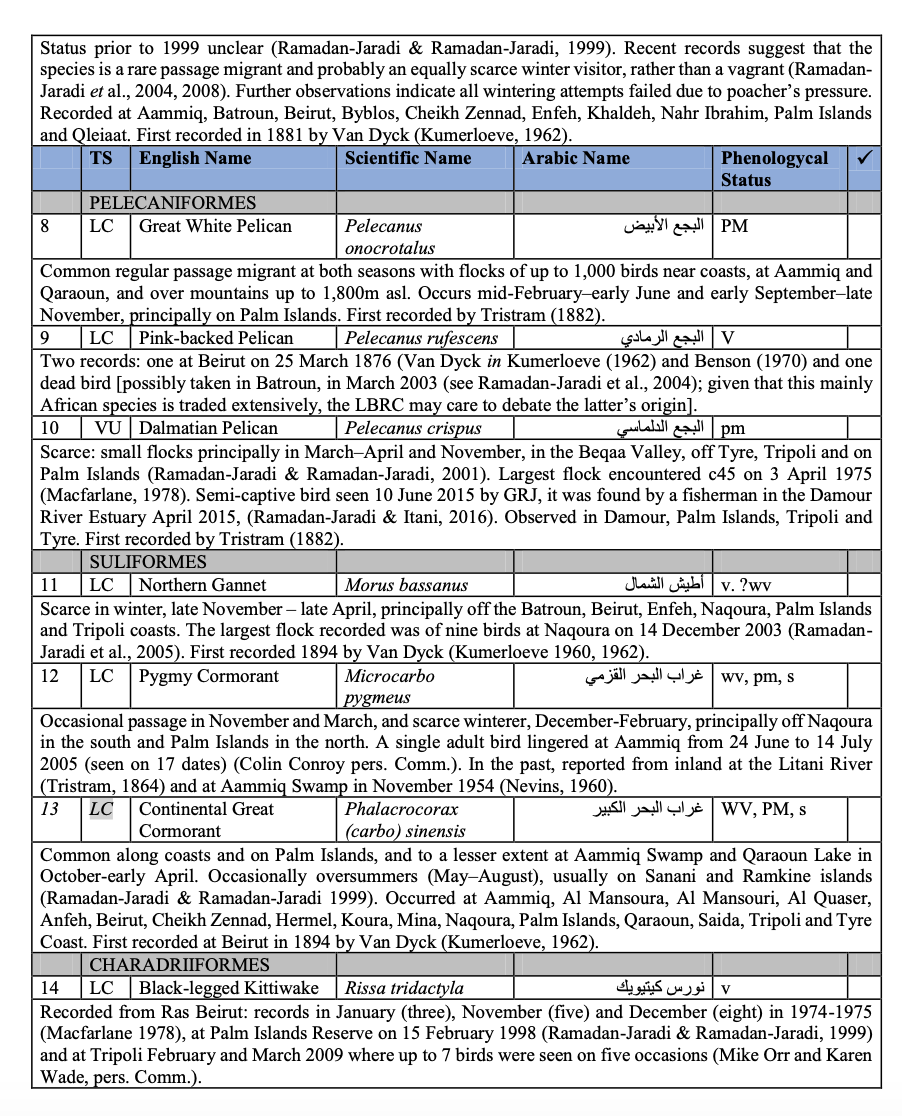
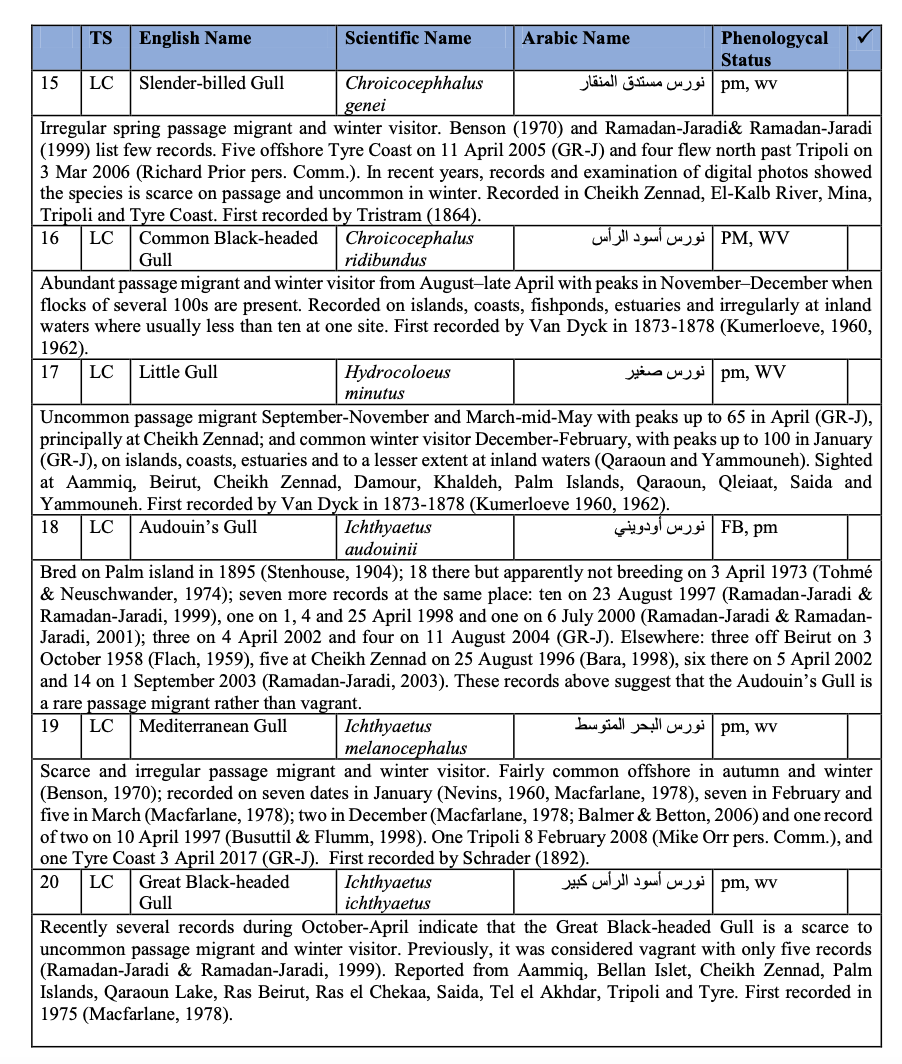
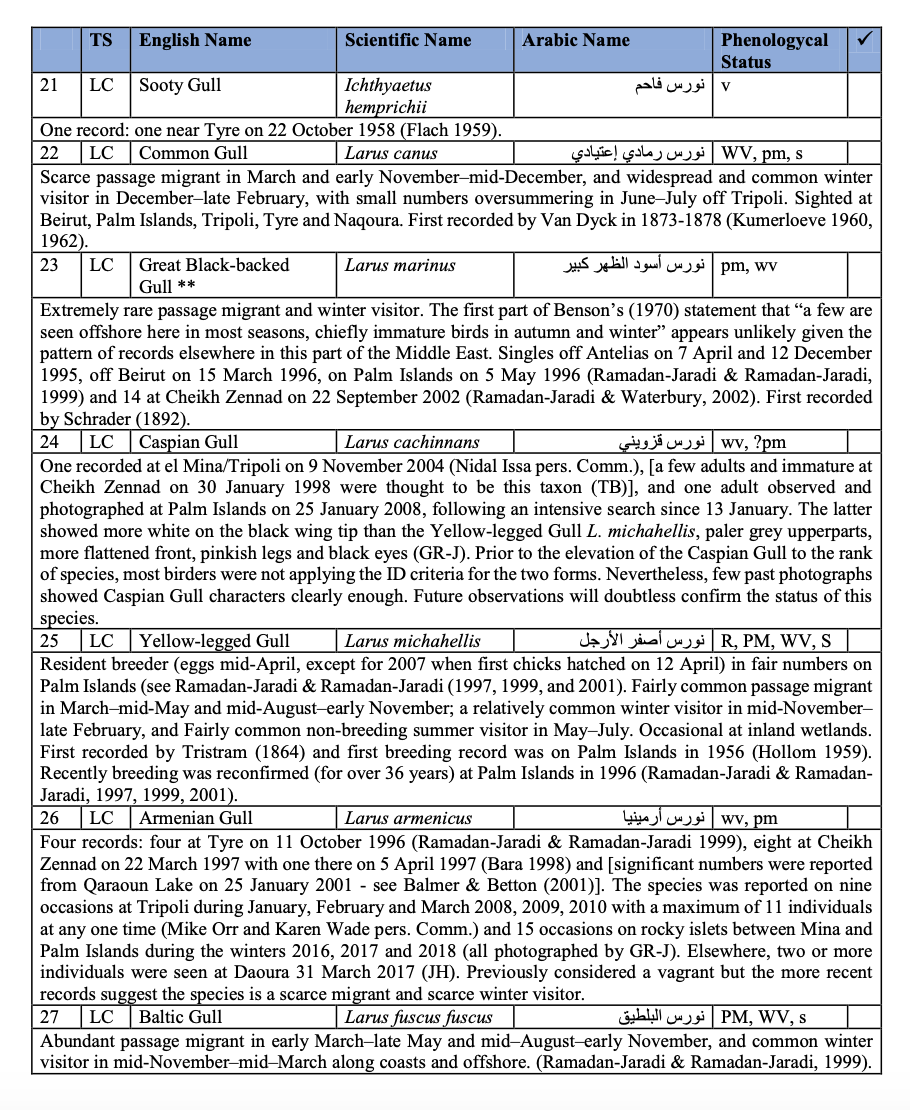
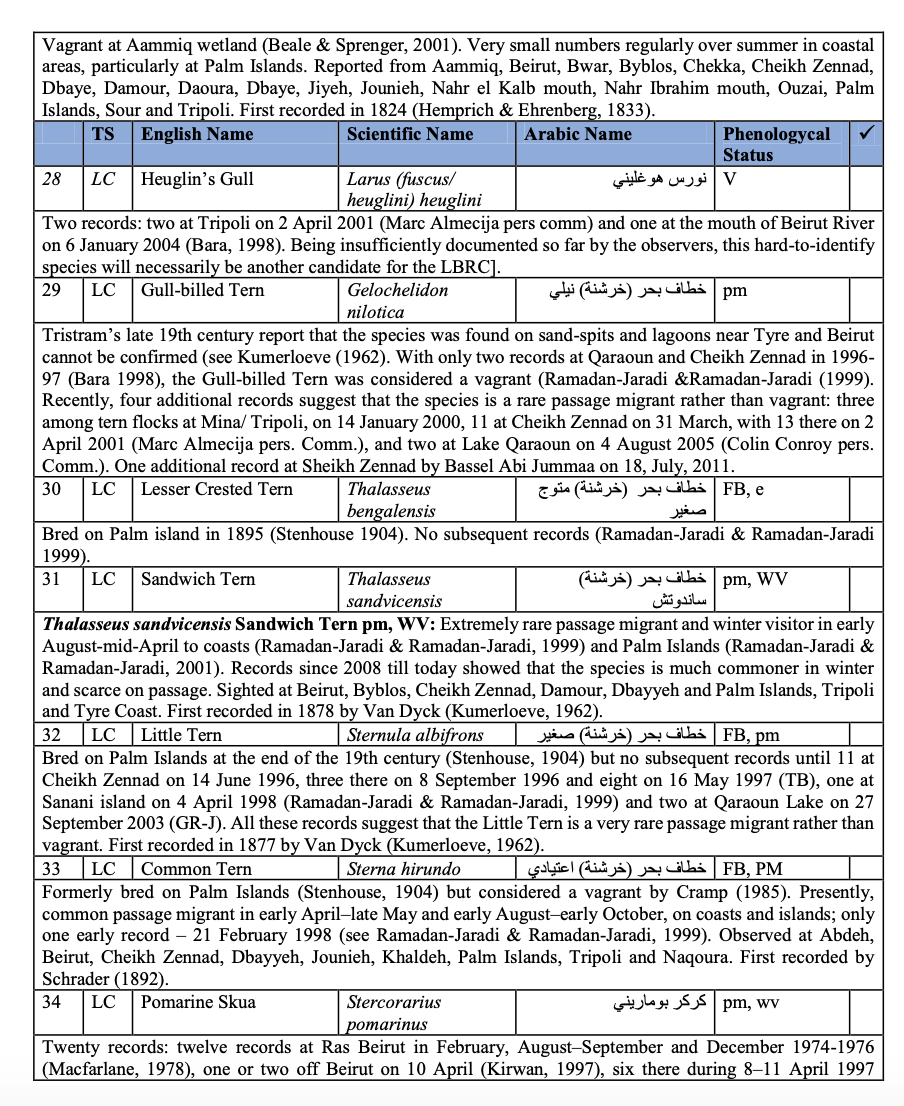
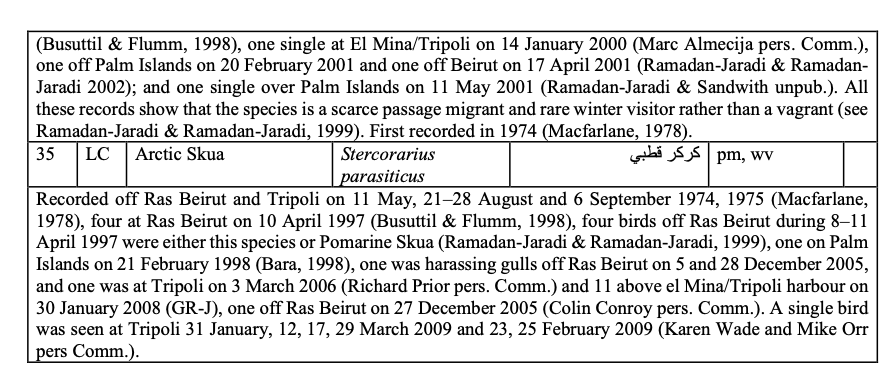
Coastal Avian Species
The coastal wetlands, rocky shores, sandy beaches, shallow waters and mudflats of Lebanon support a wide variety of shorebirds. Shorebirds include plovers, sandpipers, oystercatchers, and turnstones. In some regions, shorebirds are considered wading birds. The following are the coastal birds of Lebanon: (Table 2)
Table 2. Annotated checklist of the coastal bird species.
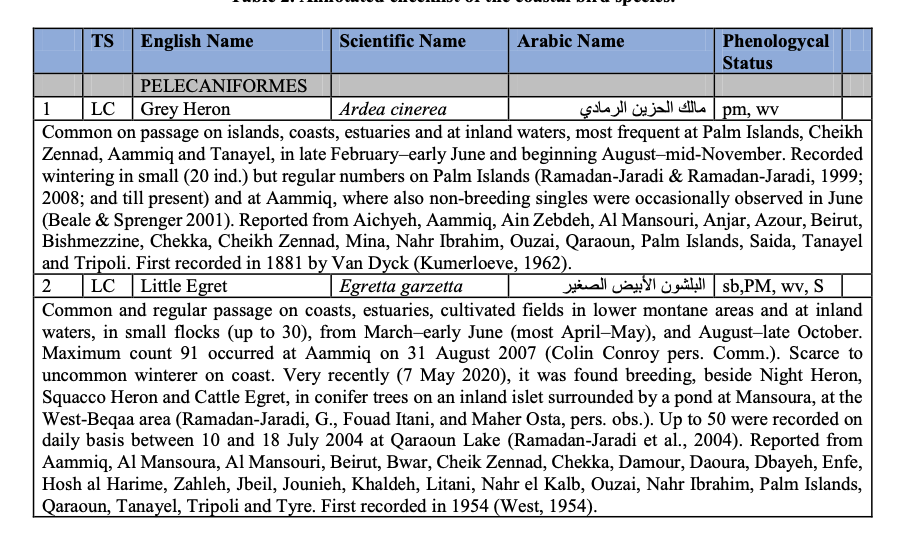
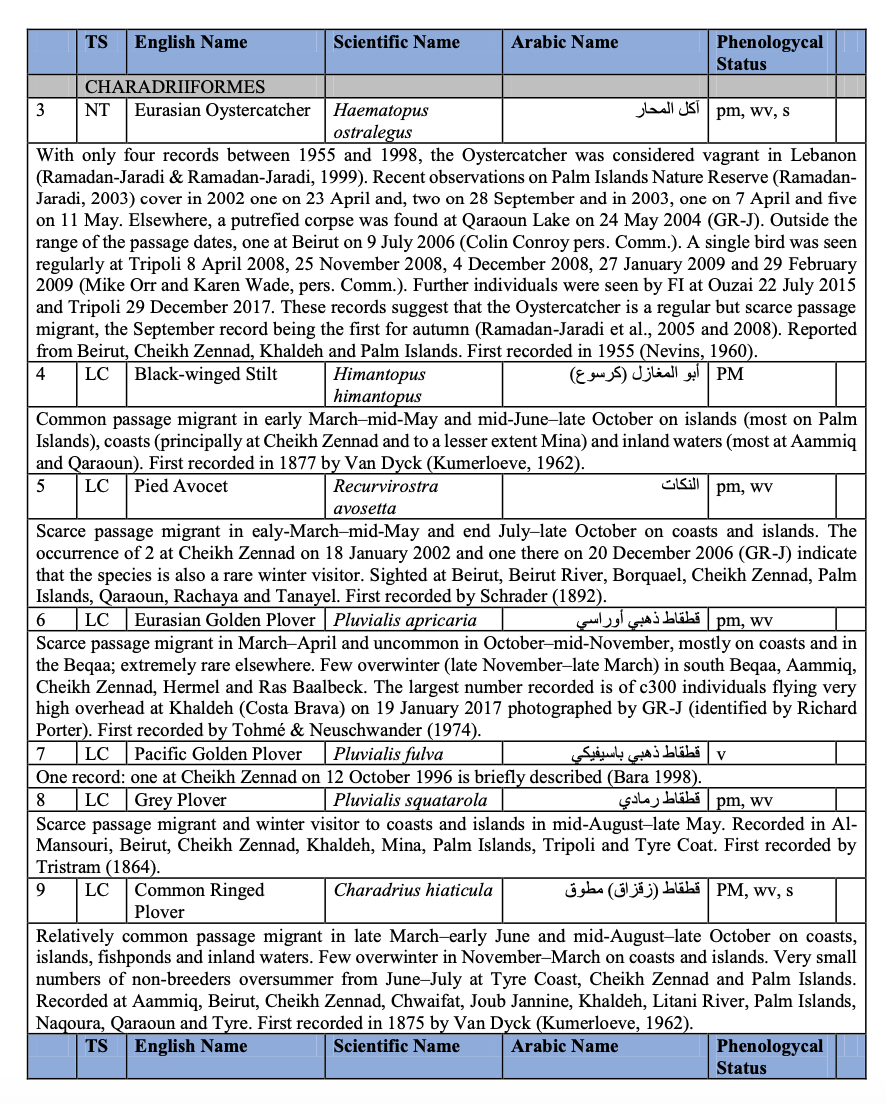
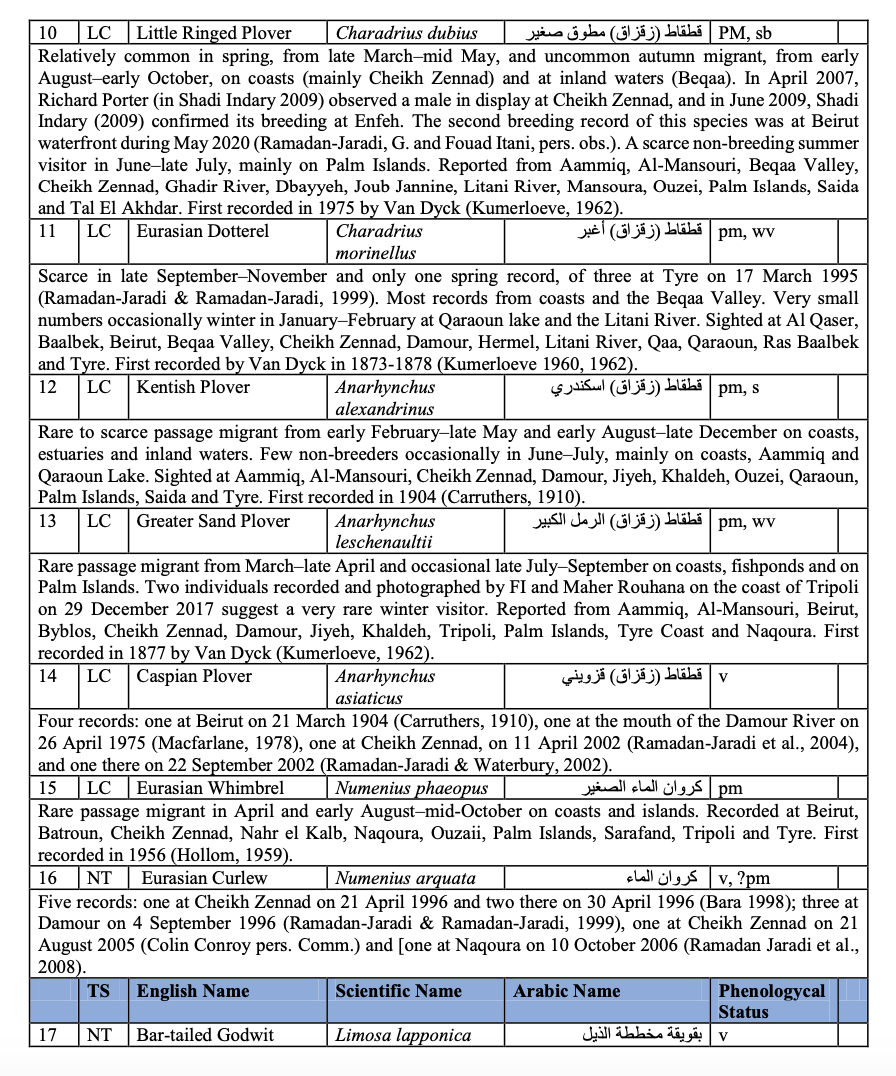
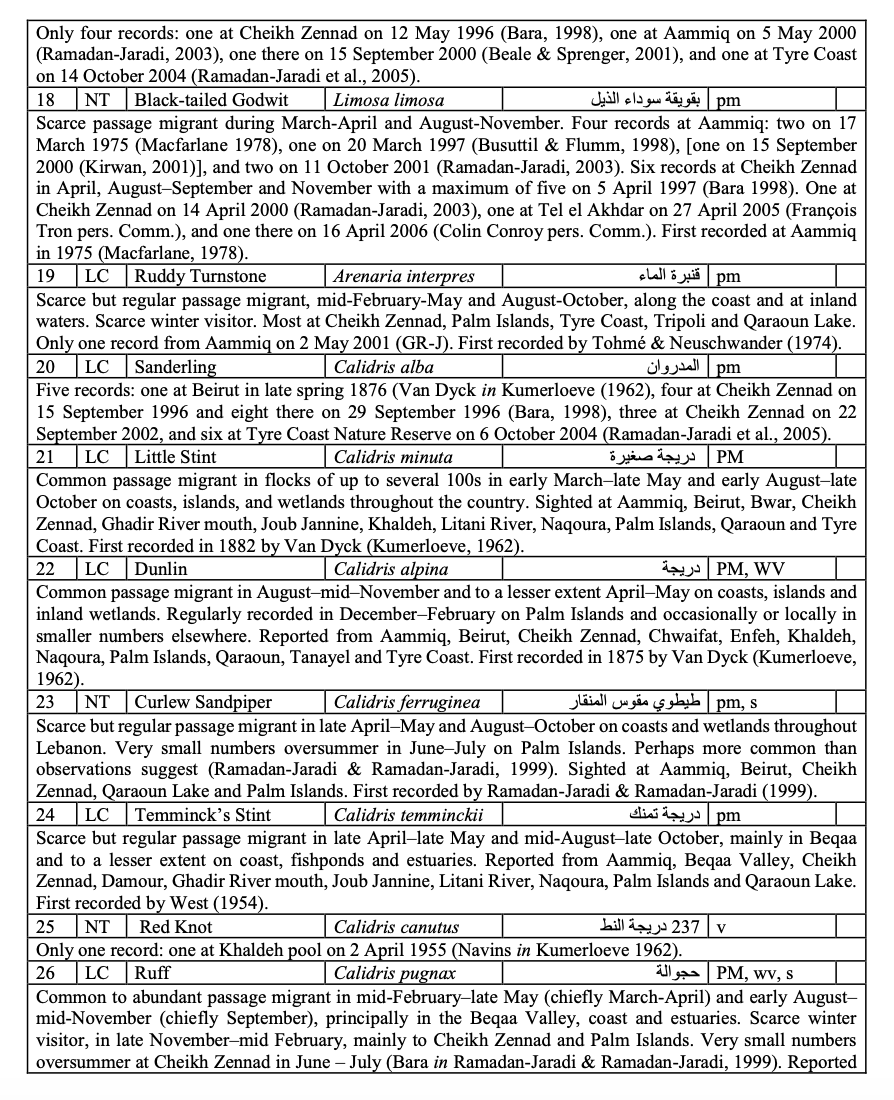
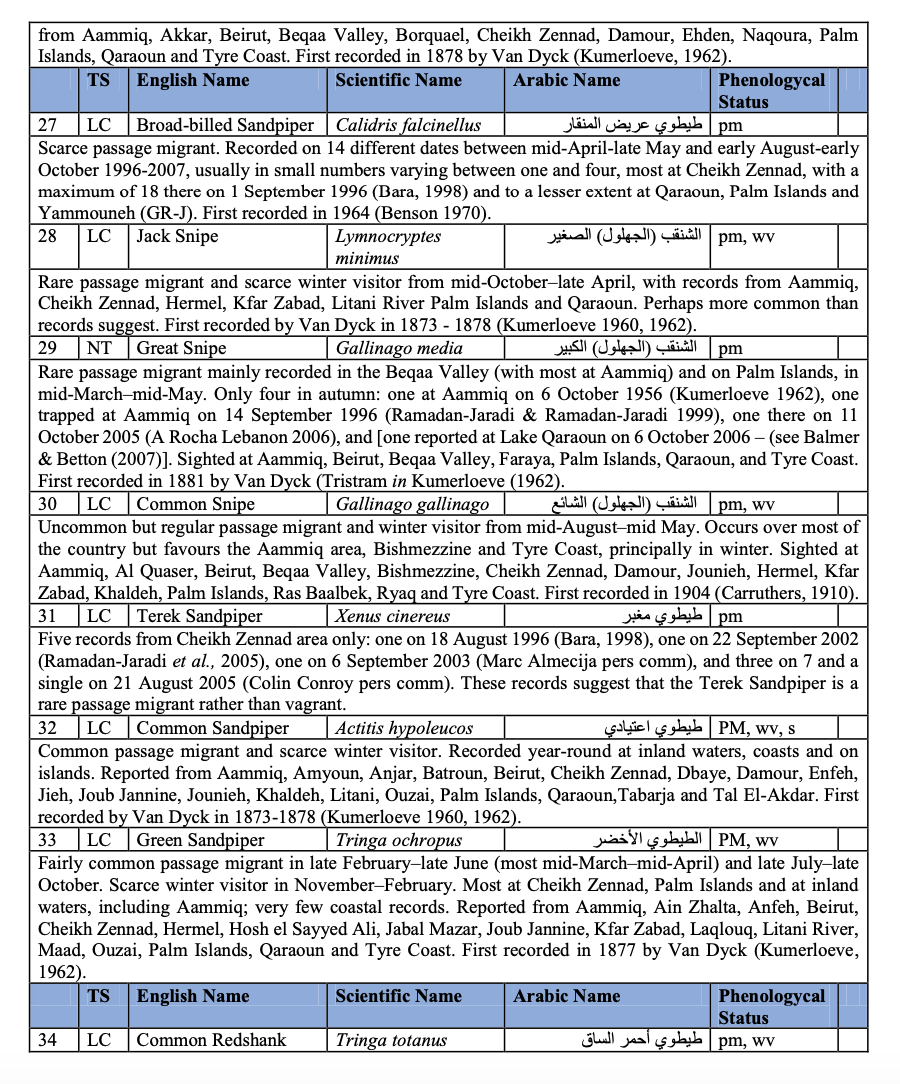
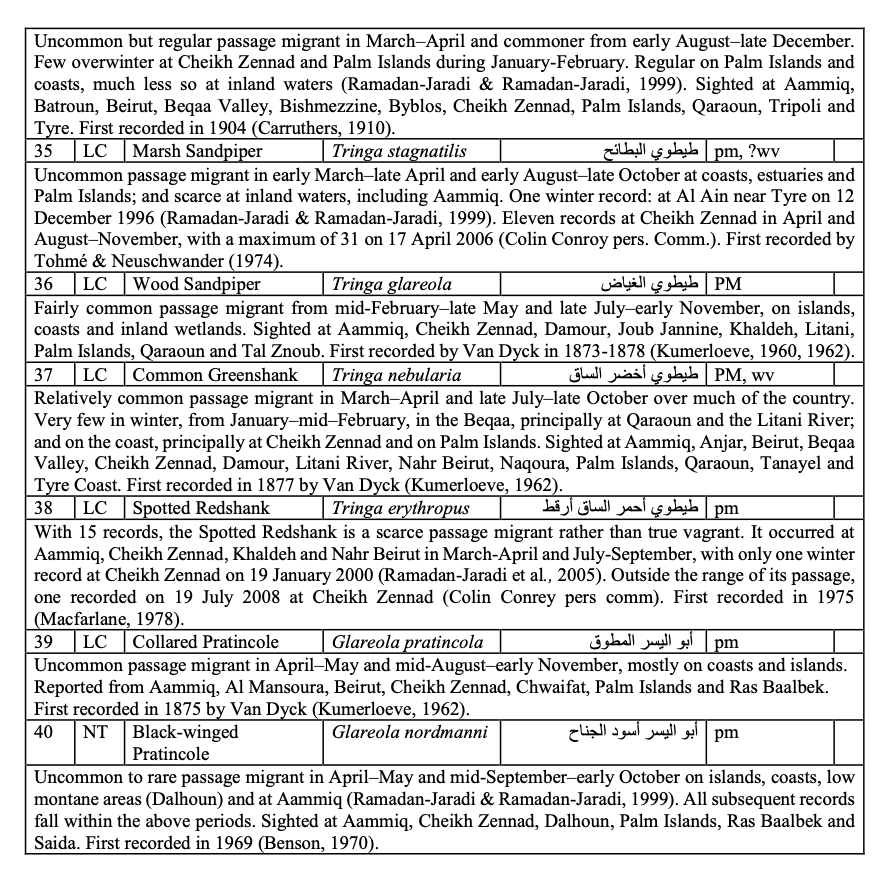
Pratincole
Uncommon to rare passage migrant in April–May and mid-September–early October on islands, coasts, low montane areas (Dalhoun) and at Aammiq (Ramadan-Jaradi & Ramadan-Jaradi, 1999). All subsequent records fall within the above periods. Sighted at Aammiq, Cheikh Zennad, Dalhoun, Palm Islands, Ras Baalbek and Saida. First recorded in 1969 (Benson, 1970).
ACKNOWLEDGEMENT
This work was undertaken through a grant from the National Council for Scientific Research, Lebanon. Thanks, are extended to the Ministry of Environment of Lebanon and the IUCN for facilitating my work in the field, and to my dear friend Fouad Itani for his willingness to provide the photos of the birds recorded.
REFERENCES
Balmer, D. & K. Betton. (2001). Around the Region. Sandgrouse 23: 156-160.
Balmer, D. & K. Betton. (2006). Around the Region. Sandgrouse 28: 90-96.
Balmer, D. & K. Betton. (2007). Around the Region. Sandgrouse 29: 9-16.
Bara, T. (1998). Selected records from Cheikh Zennad, a coastal wetland in north-west
Lebanon. Sandgrouse 20: 40–45.
Beale, CM & A Sprenger. (2001). The Birds of the Aammiq Area. A Rocha 2000-2001
Report, Lebanon.
Benson, SV. (1970). Birds of Lebanon and the Jordan area. International Council for Bird
Preservation, Cambridge and Warne, London, UK. Birdlife International. (2018). What are seabirds?
Blondel, J., Ferry, C., & Frochot, B. (1981). Point counts with unlimited distance. Studies in Avian Biol., 6, 414-420.
Busuttil, S., & Flumm, D. (1998). Seawatching at Ras Beirut, Lebanon in spring 1997. Sandgrouse, 20, 142-143.
Carruthers, D. (1910). On a collection of birds from the Dead Sea and north-western Arabia, with contributions to the ornithology of Syria and Palastine. Ibis (IX) 4: 475-491.
Cawkell, E. M. (1944). Notes on some birds in the Beirut area littoral. Bull. Zool. Soc. Egypt, Syria-Palest. Suppl. 6, 23-25.
Cramp, S. (ed). (1985). The Birds of the Western Palearctic, (4), OUP, Oxford, UK. Evans, MI. (1994). Important Bird Areas in the Middle East. BirdLife Conservation
Series. No 2. BirdLife International, Cambridge, UK.
Flash, B. (1959). Höstobservationer i Libanon. Fauna och Flora 1959: 161–180. Hemprich, FG. & CG. Ehrenberg. (1833). Symbolae Physica seu Icones et Descriptiones
Avium quae ex itinere per Africam Borealem et Asiam Occidentalem. Berlin.
Germany.
Hollom, P. A. D. (1959). Notes from Jordan, Lebanon, Syria and Antioch. Ibis, 101, 183-
200.
Kirwan, GM. (1997). Around the Region. Sandgrouse 19: 156-160.
Kirwan, GM. (2001). Around the Region. Sandgrouse 23: 76-80.
Kumerloeve, H. (1960). The Bird-Collection of W. Th. Van Dyck (1857-1939) in the
museum of the American University of Beirut. Alauda 28-2: 124-128. Kumerloeve, H. (1962). Notes on the birds of the Lebanese Republic. Iraq Nat. Hist. Mus.
Publ. 20 (21), 1-81.
Macfarlane, A. M. (1978). Field notes on the birds of Lebanon and Syria, 1974-1977.
Army Bird-watching Soc. Per. Publ. 3.
MOE, IUCN, UN Environment & GEF (2018). Assessment of the Management
Effectiveness of Marine Protected Areas in Lebanon. Terms of Reference. “Policy and Legislative Development for Mainstreaming the Sustainable Management of Marine and Coastal Ecosystems in Lebanon” Project.
Nevins, J. (1960). Partial check-list of the birds of Lebanon. Unpubl. manuscript. Ramadan-Jaradi, G., & Ramadan-Jaradi, M. (1997). Notes on some breeding birds of
Lebanon. Sandgrouse, 19, 122-125.
Ramadan-Jaradi, G., & Ramadan-Jaradi, M. (1999). An updated checklist of the birds of
Lebanon. Sandgrouse, 21, 132-170.
https://www.birdlife.org/europe-and-
central-asia/seabirds-and-marine-what-are-seabirds
Lebanese Science Journal, Vol. 21, No. 1, 2020 53
Ramadan-Jaradi, G., & Ramadan-Jaradi, M. (2001). The avifauna of Palm Islands Nature Reserve in Lebanon 1893-2000. Lebanese Science Journal, 2(1), 17-35.
Ramadan-Jaradi, G., & Ramadan-Jaradi, M. (2002). Population size of the Syrian Serin Serinus syriacus and other ornithological records from Lebanon. Lebanese Science Journal, 3(1), 27- 35.
Ramadan-Jaradi, G. & J. Waterbury (2002). Notes on the birds of Cheikh Zennad. Unpubl. Manuscript.
Ramadan-Jaradi, G., Bara, T., Al-Mecija, M., & Ramadan-Jaradi, M. (2004). Significant bird notes from Lebanon during 2002-2003. Sandgrouse, 26(1), 29-34.
Ramadan-Jaradi, G., Waterbury S. P., & Ramadan-Jaradi, M. (2005). Ornithological observations from Lebanon during 2003-2004. Sandgrouse, 27(1), 69-73.
Ramadan-Jaradi, G. (2006). Status of Marine and Coastal bird species in Lebanon. Proceeding of the first symposium on the Mediterranean Action Plan for the conservation of marine and coastal birds. UNEP; MAP; RAC/SPA. Oct. 2006.
Ramadan-Jaradi, G., Bara, T., & Ramadan-Jaradi, M. (2008). Revised checklist of the birds of Lebanon 1999-2007. Sandgrouse, 30(1), 22-69.
Ramadan-Jaradi, G. (2010). Rehabilitation of Economic Functions of War-damaged Palm Islands Nature Reserve (PINR) Lebanon. Obtained on 20/12/2010 the Prize of KSA for the best environmental management in Arab countries that was organized by the Arab League States.
Ramadan-Jaradi, G. (2017a). Status and Distribution of Migrating and breeding sea birds in north Lebanon. Lebanese Science Journal, 18(2).
Ramadan-Jaradi, G. (2017b). National Monitoring Programme for Biodiversity in Lebanon – EO1 – Seabirds. Developed for Ecap and MedMPA net II Lebanon.
Ramadan-Jaradi, G. (2017c). Training on the identification of the marine birds with focusing on threatened and endangered species. Supported by RAC-SPA, 2017.
Ramadan-Jaradi, G. (2017d). National Monitoring Programme for Biodiversity in Lebanon – EO1 – Seabirds, Study Report on behalf of SPA-RAC/Barcelona Convention. Tunisia.
Ramadan-Jaradi, G., & Itani, F. (2018). Two new species for Lebanon, White headed Duck Oxyura leucocephala and Eyebrowed Thrush Turdus obscurus, and two other interesting records for Lebanon.
Schrader, G. (1892). Ornithologische Beobachtungen auf meinen Sammelreisen. III. Syrien. Orn. Jhrb. 3: 11-17.
Steele, J. (2008).
Stenhouse, J. H. (1904). The birds of Nakhl island on the coast of Syria. Ibis (VIII), 4, 29- 32.
Tohmé, G., & Neuschwander, J. (1974). Nouvelles données sur l’avifaune de la République Libanaise. Alauda, 13, 243-258.
Tristram, HB. (1864). Report on the birds of Palestine. Proc. Zool. Soc. London 426- 456.
Tristram, HB. (1882). Ornithological notes of a journey through Syria, Mesopotamia, and southern Armenia in 1881. Ibis 6(IV), 402-419.
Tully, J. r., Dorresrein, G., Jones, A., & Cooper, J. (2009). Handbook of Avian Medicine. 2nd Edition. Saunders Ltd.
West, D (1954). Nature notes from the Lebanon. Toronto Field Natur. Club 126: 1-11.
Encyclopedia of Ocean Sciences, Second Edition. Academic Press.
ISBN:
978-0-12-374473-9.
